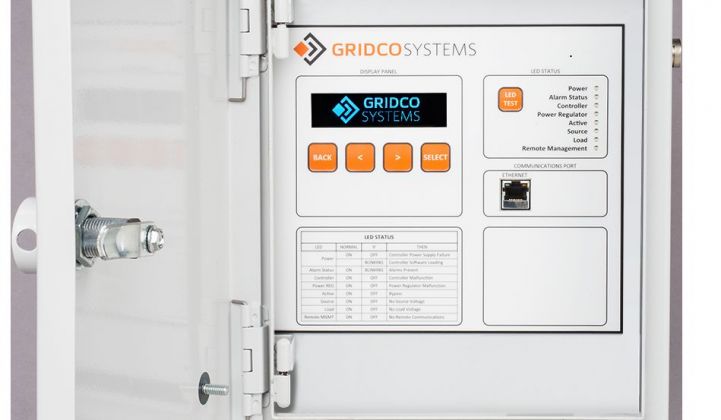Gridco Systems, one of a handful of startups building power electronics devices that can manage electricity fluctuations and disturbances at the distribution grid level, has ceased operations and is selling its assets to satisfy creditors.
It’s not that its technology didn’t work -- it does, according to multiple pilot projects with utilities including Duke Energy, Hawaiian Electric, California’s Sacramento Municipal Utility District, and Ontario, Canada’s Greater Sudbury Hydro. Gridco’s in-line power regulators (IPRs) have stabilized solar-driven voltage surges, hit their set points for voltage and reactive power, and otherwise demonstrated a previously unattained level of control over the distribution grid.
But utilities have failed so far to expand their use of distribution grid-level power electronics much beyond the pilot phase, leaving Gridco with little opportunity to grow to the scale necessary to maintain its operations on the strength of its own revenues.
“Though we were able to successfully prove Gridco’s technology as best-in-class for use in utility-scale volt/VAR optimization programs, the VVO market did not actualize quickly enough for us to achieve critical mass and financial self-sustainability,” said CEO Naimish Patel, in a recent interview.
Gridco, which raised $54 million from investors including General Catalyst, Lux Capital and North Bridge Venture Partners, sought multiple fundraising and strategic options through the course of 2017, he said. But late in the year, as the remaining options failed to materialize, the company decided to close on Dec. 31. Gridco’s website now shows only this information, and the phone number of Verdolino & Lowey, the firm hired to liquidate Gridco’s assets “to the benefit of our creditors.”
GTM Research had predicted a $320 million U.S. market by 2017 for these kinds of devices. But as Ben Kellison, director of grid research at GTM Research, noted, "the utility-owned distribution power electronics market has been much slower to develop than GTM Research and much of the industry has expected.”
Gridco has several competitors in this still-nascent field, including Varentec, GridBridge, Apparent Energy, Faraday Grid and others still in stealth mode. Power electronics serving the higher-voltage realms of the grid are already a significant business for ABB and other grid giants, and startup Smart Wires has devices to manage power flows on the transmission grid.
But throughout 2017, GTM Research has tracked only one big deal involving distribution grid power electronics. Xcel Energy’s $612 million smart meter and smart grid rate case last year included plans to purchase 4,350 Varentec devices between 2017 and 2022 to reduce unnecessary over-voltages on distribution circuits.
One key reason for the market’s slower-than-expected growth is that the key business case -- helping to integrate higher penetrations of distributed solar into distribution grids -- hasn’t become as big a problem for utilities as many had expected, Kellison noted. “As utilities gained more experience with distributed solar, distribution planners and operators have realized that distribution grids are more robust and tolerant of intermittent generation at the edge than most engineers would have thought five years ago,” he said.
That’s left conservation voltage reduction (CVR) and VVO as the main business case for deploying these kinds of devices today. But here, Gridco and other distributed power electronics providers must contend with competition from companies like Utilidata and DVI, which use grid-tied sensors and smart meters, respectively, to better inform CVR and VVO schemes and devices in the field.
The slow pace of adoption has put other contenders in the distribution grid power electronics field under financial pressure. Earlier this year, GridBridge was acquired by Ermco, a Tennessee-based distribution transformer manufacturer, for an undisclosed price.
“Power electronics-based voltage and reactive power control devices will become important as renewable penetration increases,” Kellison said. Once deployed, they can also enhance control over voltage and power quality, as well as analyze and report on the actual waveform of the energy flowing through the lines they’re connected to.
“However, it remains to be seen if most of these devices will be smart inverters at the site of distributed generation or storage, utility-owned and connected to LV transformers, or pole- or pad-mounted devices supporting the medium-voltage grid,” he said.
Patel noted that Gridco’s existing customers will continue to be able to use its deployed products in “set-and-forget mode,” automatically managing voltage fluctuations and tripping off-line when appropriate. But Gridco’s cloud-hosted management software service will no longer be available to monitor and manage them.
“Though we are disappointed with the outcome, we remain confident as to the value of Gridco’s technology and IP,” both of which are for sale, Patel added. While he wouldn’t comment on prospective buyers for either category of Gridco’s assets, he said he’s optimistic that it will be put to work in the future by “utilities endeavoring to deliver higher energy efficiency and power quality, particularly as consumer adoption of distributed generation and electric vehicles grows.”




